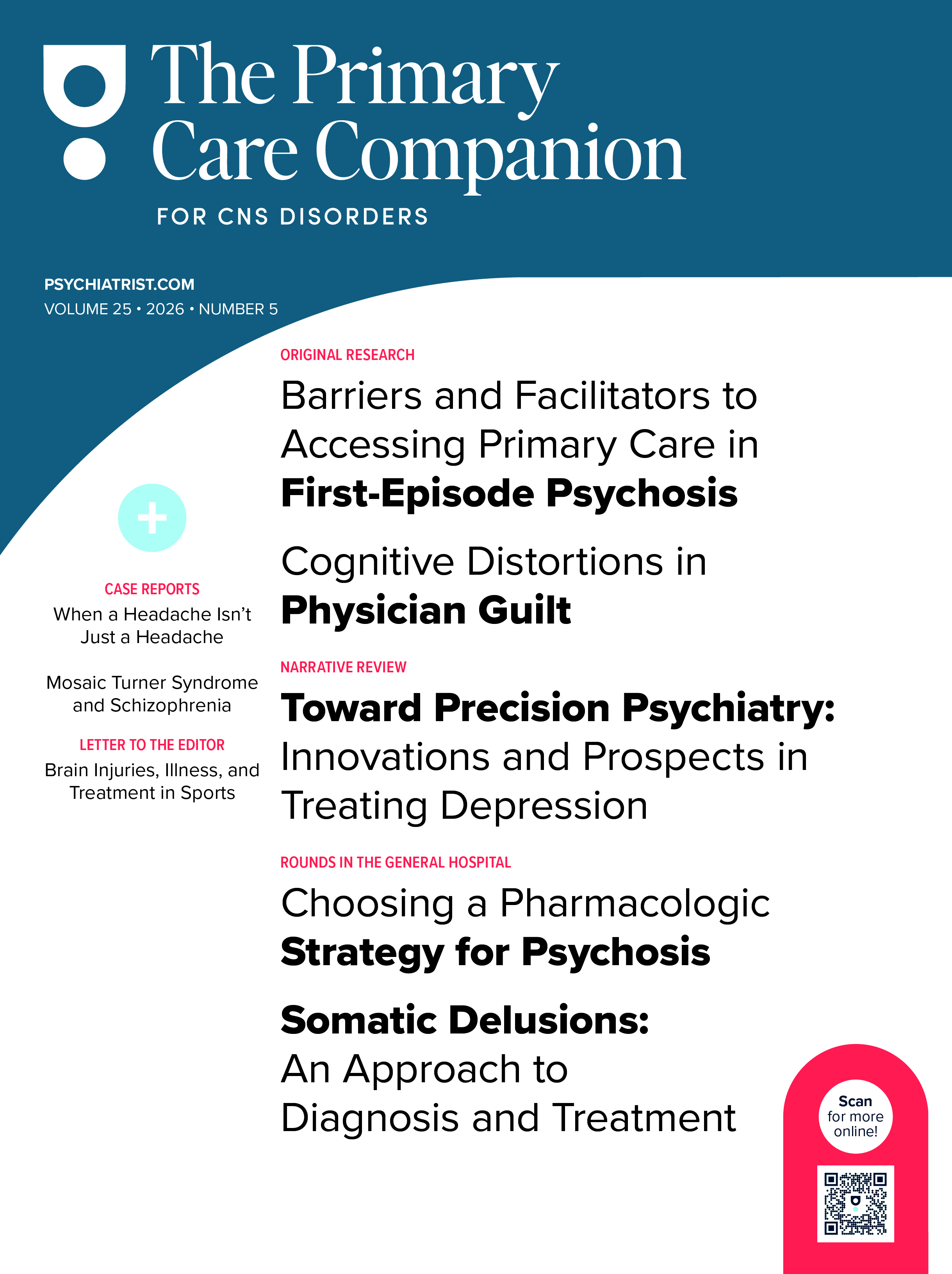
To cite: Gupta M. Rare side effects of stimulants: Raynaud’s phenomenon. Prim Care Companion CNS Disord. 2021;23(5):20l02857.
To share: https://doi.org/10.4088/PCC.20l02857
© Copyright 2021 Physicians Postgraduate Press, Inc.
aClarion Psychiatric Center, Clarion Pennsylvania
*Corresponding author: Mayank Gupta, MD, Clarion Psychiatric Center, 2 Hospital Dr, Clarion, PA 16214 ([email protected]).
Prim Care Companion CNS Disord 2021;23(5):20l02857
Psychostimulants (Adderall, Dexedrine, and Ritalin) are a US Food and Drug Administration–approved treatment for attention-deficit/hyperactivity disorder (ADHD).1 According to the US Centers for Disease Control and Prevention, approximately 3.5% of children between the ages of 0 and 11 years and 6.2% (most common) between 12 and 19 years are prescribed stimulants.2 Secondary Raynaud’s phenomenon3-6 is a rare but distressing adverse effect of stimulants.
Case Report
The patient was a 15-year-old girl with a diagnosis of oppositional defiant disorder, ADHD combined type, and Raynaud’s phenomenon. She was initially treated with 10 mg of Adderall with the plan to increase to 20 mg after 2 weeks. One week after the initiation of treatment, she began to experience daily recurrence of Raynaud episodes. The patient reported that prior to starting the psychostimulant, her Raynaud episodes were triggered after showers and during the winter season about 3 times per week. These episodes presented as a purple fourth finger bilaterally and purple feet and legs bilaterally with mottling.7 However, while she was taking Adderall, these symptoms would present every day in the evening before her shower and manifested in the same fashion as her “regular” Raynaud episodes.8 Each episode lasted for approximately 2 hours with no sensory changes or weakness. Her family physician decided to refer her to the child psychiatry clinic. After carefully reviewing the history, it was decided to take her off Adderall. Four days after the medication was stopped, the evening episodes of Raynaud subsided. She was investigated for collagen vascular disease to rule out any medical cause, but all the results were negative. The patient was switched to guanfacine extended release 2 mg after 1 month. At the time of this writing, she is well maintained on this dose with moderate reduction in her symptoms.
Discussion
Raynaud’s phenomenon has been previously reported with the use of psychostimulants. Raynaud’s phenomenon is primarily caused by peripheral release of catecholamines, which leads to vasoconstriction.9 The empirical evidence has linked more cases with mixed salt amphetamines compared to methylphenidate.10 These differences may be due to their distinct pharmacodynamic profiles. Methylphenidate is primarily a reuptake inhibitor of catecholamines, but mixed salt amphetamines, in addition to reuptake inhibition, also release catecholamines.11 Mixed salt amphetamines also have higher potency compared to methylphenidate, which is established in vivo12 and in cross-over studies. The European Society of Vascular Medicine13 published expert’s consensus guidelines defining mild symptoms including Raynaud’s phenomenon and severe manifestations, which need immediate tertiary-level interventions. A 2020 case series14 reported 3 cases of methylphenidate-induced life-threating systematic sclerosis. All of these patients had Raynaud’s phenomenon and were positive for anti-nuclear antibodies. Another case of dose-dependent Raynaud’s phenomenon in an adult patient was reported in which symptoms improved with reduction of the dose.15 The peripheral manifestations of stimulants are worse in patients with underlying rheumatologic disease, including development of gangrene and need for amputations.16 Therefore, careful history and screening for rheumatologic disorders are recommended. The clinician’s awareness of these adverse effects is critical in effectively addressing these conditions and modifying the treatment.
Published online: September 23, 2021.
Potential conflicts of interest: None.
Funding/support: None.
Additional information: All clinical information has been de-identified to protect anonymity.
References (16)

- American Academy of Child & Adolescent Psychiatry. ADHD Parents Medication Guide. July 2013. American Psychiatric Association. Accessed August 11, 2021. https://www.psychiatry.org/File%20Library/Psychiatrists/Practice/Professional-Topics/Child-Adolescent-Psychiatry/adhd-parents-medication-guide.pdf
- Prescription Drug Use in the United States. 2015-2016. NCHS Data Brief No. 334. Centers for Disease Control and Prevention. May 2019. Accessed August 11, 2021. https://www.cdc.gov/nchs/products/databriefs/db334.htm
- Gnanavel S. Lisdexamfetamine and secondary Raynaud’s phenomenon. Prim Care Companion CNS Disord. 2018;20(5):17l02240. PubMed CrossRef
- Bayram Ö, Hergüner S. OROS-methylphenidate-induced Raynaud’s phenomenon: a dose-related side effect. J Child Adolesc Psychopharmacol. 2015;25(6):521–522. PubMed CrossRef
- Syed RH, Moore TL. Methylphenidate and dextroamphetamine-induced peripheral vasculopathy. J Clin Rheumatol. 2008;14(1):30–33. PubMed CrossRef
- Goldman W, Seltzer R, Reuman P. Association between treatment with central nervous system stimulants and Raynaud’s syndrome in children: a retrospective case-control study of rheumatology patients. Arthritis Rheum. 2008;58(2):563–566. PubMed CrossRef
- Al Aboud A, Abrams M, Mancini AJ. Blue toes after stimulant therapy for pediatric attention deficit hyperactivity disorder. J Am Acad Dermatol. 2011;64(6):1218–1219. PubMed CrossRef
- Yu ZJ, Parker-Kotler C, Tran K, et al. Peripheral vasculopathy associated with psychostimulant treatment in children with attention-deficit/hyperactivity disorder. Curr Psychiatry Rep. 2010;12(2):111–115. PubMed CrossRef
- Khouri C, Blaise S, Carpentier P, et al. Drug-induced Raynaud’s phenomenon: beyond β-adrenoceptor blockers. Br J Clin Pharmacol. 2016;82(1):6–16. PubMed CrossRef
- Iglesias Otero M, Portela Romero M, Bugarín González R, et al. Methylphenidate and secondary Raynaud’s phenomenon [in Spanish]. Semergen. 2013;39(6):330–334. PubMed CrossRef
- Arnold LE. Methyiphenidate vs amphetamine: comparative review. J Atten Disord. 2000;3(4):200–211. CrossRef
- Goodwin JS, Larson GA, Swant J, et al. Amphetamine and methamphetamine differentially affect dopamine transporters in vitro and in vivo. J Biol Chem. 2009;284(5):2978–2989. PubMed CrossRef
- Belch J, Carlizza A, Carpentier PH, et al. ESVM guidelines—the diagnosis and management of Raynaud’s phenomenon. Vasa. 2017;46(6):413–423. PubMed CrossRef
- Meridor K, Levy Y. Systemic sclerosis induced by CNS stimulants for ADHD: a case series and review of the literature. Autoimmun Rev. 2020;19(1):102439. PubMed CrossRef
- Monteerarat Y, Pariwatcharakul P. Methylphenidate-induced Raynaud phenomenon developed after increasing methylphenidate in an adult with attention-deficit hyperactivity disorder. J Clin Psychopharmacol. 2019;39(2):178–179. PubMed CrossRef
- Tan G, Mintz AJ, Mintz B, et al. Peripheral vascular manifestation in patients receiving an amphetamine analog: a case series. Vasc Med. 2019;24(1):50–55. PubMed CrossRef
Please sign in or purchase this PDF for $40.


